
‘My pieces are like nature, they carry on living’
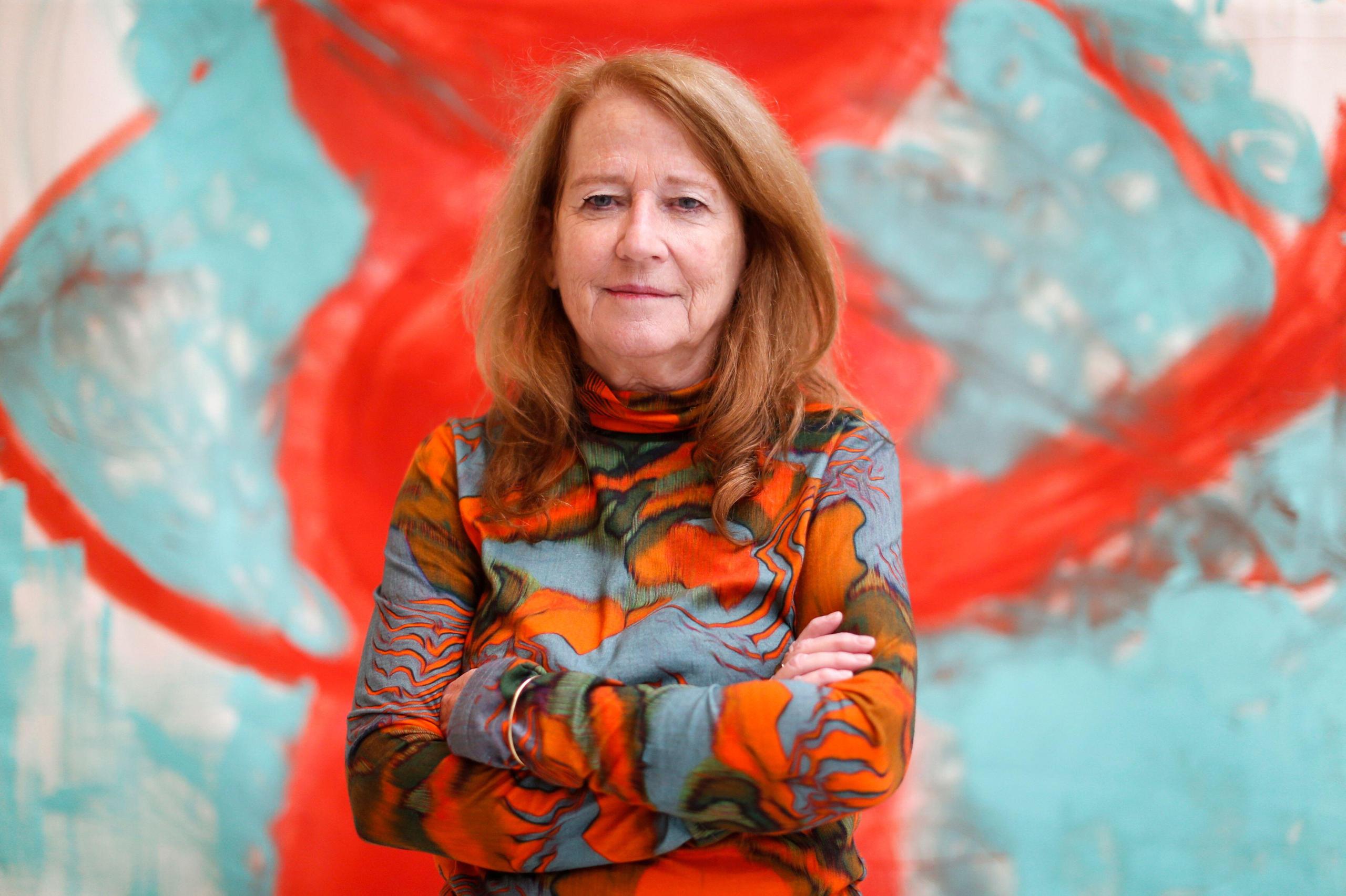
It took a long time for the art world to rediscover Vivian Suter, who this year was awarded the Prix Meret Oppenheim, the most important Swiss art award. When she left Switzerland at the beginning of the 1980s, people in the art scene didn’t understand why and quickly dismissed her. Her radical decision now seems the most appropriate thing an artist could do.
Many artists are now much more concerned about climate change than about the art market or want to combine both in a new context governed by sustainable conditions. For the young generation, Vivian Suter has therefore become an inspiring model who found a way to deal with her environment respectfully, without making concessions; for the others, she is an independent and powerful ecofeminist.
Over recent decades, though, the Swiss artist born in Buenos Aires (Argentina) in 1949, and living next to a volcano in the rainforest by Lake Atitlán, hasn’t attracted much interest. It was only recently that several of her paintings were bought by the prestigious Art Institute of Chicago and she was invited to participate in Kassel’s documenta. Finally, her time had come.
More than that, her singular way of life became an asset, her off-centre position a curiosity. Curators felt as if they were discovering a hidden treasure, rather like a previously unknown species of bird.
A retrospective of Vivien Suter’s work opens on November 6 in the Kunstmuseum Luzern, with a public conversation between the artist and the curator Fanni Fetzer at 1pm. The exhibition runs until February 13 2022.
Back in prestigious museums, Suter has been moved by the professionalism of the restorers, who handle her paintings carefully, discuss how to protect them and think about the best way to store them. She has admired the way they have embraced canvases still full of wildness, bearing the marks of nature – leaves, mud, smells.
Although her primary aim was to start making art from scratch, without any influences, the paintings of Vivian Suter bring together several heritages as well as nature, such as American Expressionism, Latin American magic realism and, clearly, something she inherits from her beloved mother, the artist Elisabeth Wild (1922–2020). While Wild was very controlled in her art, we can see her taste for assembling images or making collages in the imaginative way that Suter installs the artworks in space.
Suter hangs the canvas at different heights, sometimes even laying it on the ground. Put together in space, the paintings become pieces of a giant textile sculpture. Moving into it is an immersive experience that makes you feel as if you are travelling far away and feeling deeply the density of the rainforest.
The interview below is the result of an encounter on Skype, she in her beautiful house surrounded by the jungle, me by Lake Geneva. Both with rather limited English, we gathered images, anecdotes and figures in order to reconstruct the life and work of a fascinating artist who, four decades ago, chose to communicate with dogs and plants rather than with Swiss curators.
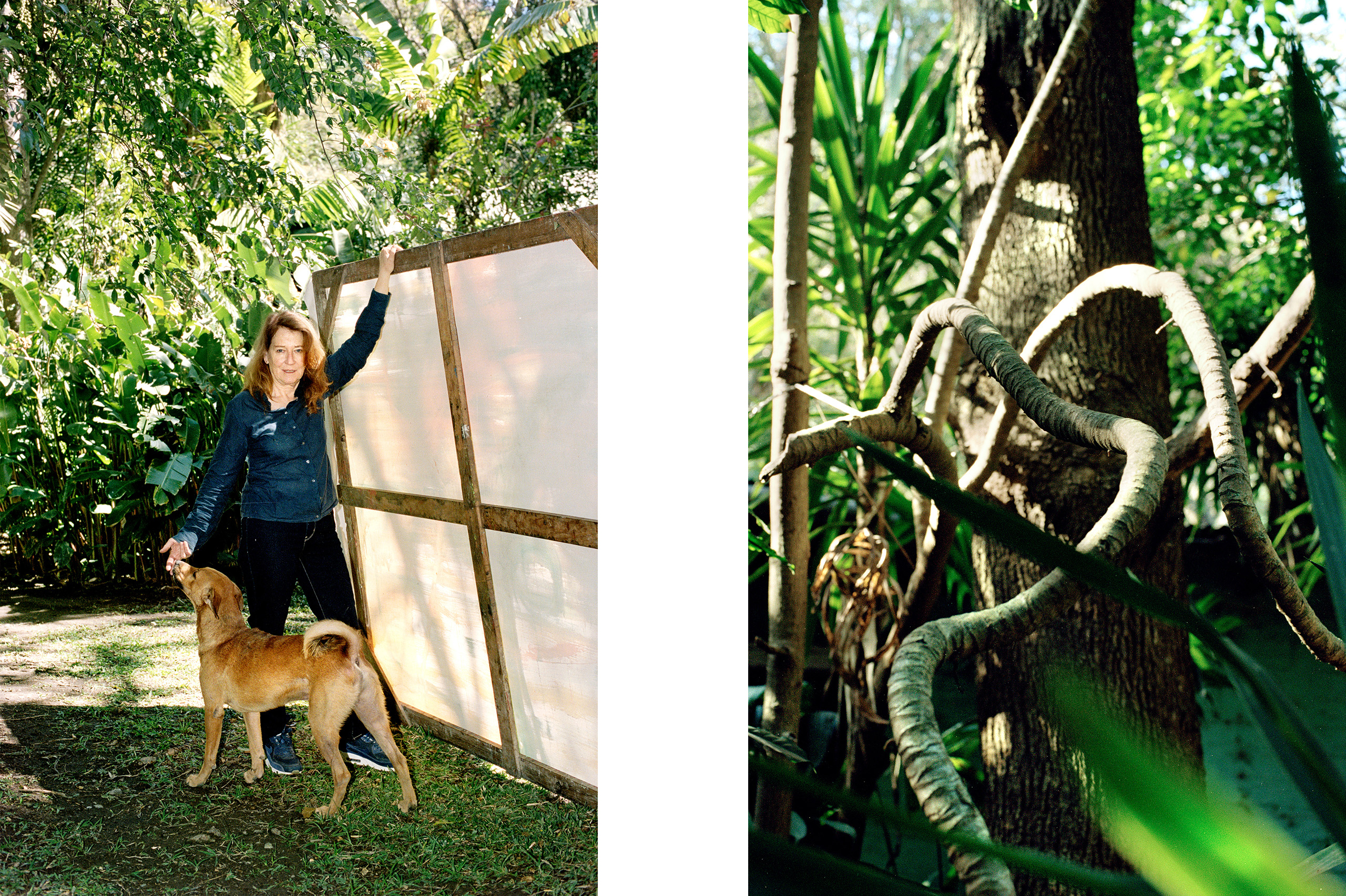
SWI swissinfo.ch: How do you start with your paintings? Do you ever draw first? How long does it take to get to the point, and so on?
Vivian Suter: I try to stay as open as possible. I do make sketches, but rarely, and not on purpose. I work on different paintings at the same time. Sometimes many at the same time. But I rarely go back to the painting when it’s done. Although maybe I feel it’s not perfect, I try to leave it and look at it again later.
Do you paint on the ground?
Sometimes. But mainly against the wall, in my studio outside, or against a tree with the stretcher too.
We could say that nature is your studio. You have to climb to get there and when you arrive, It seems that you have to look for space in the forest in order to paint… How do you stay focused in the middle of your very living garden?
My state of mind is like meditation, I am in an osmotic relation- ship with nature, which is changing all the time. I think that mobility is in my work too.
Are you ever surprised by what you are making?
Yes, I like it very much when the painting surprises me. Sometimes I Ieave my painting when it’s already dark. I have to go down the mountain with the flashlight and wait until the next day to see what I have done.
If you are disappointed, do you throw the canvas away?
No, I don’t, I just put it aside and see. And sometimes the ones that were the worst are the ones I like when I look at them the next day.
How did you find your way within the artistic scene of the 1970s, which was very conceptual?
I made paintings of different shapes; they were quite big, and that was a success when I was in Switzerland. Then I left, and I felt I had to explore some more. I decided to stay in Guatemala and gave birth to my son here. Later my mother came to live here as well.
This changed the form of my painting too. I couldn’t continue with the way I was making art in Switzerland. The outer form was very important, but I wanted to concentrate more on the inside. I couldn’t transport that kind of painting either, because it would have been complicated with shipping boxes. So I started to use material I found here, the kind of canvas and paint I got here, although I always have to bring some here from abroad.
Moving was a big decision to go back to the continent where you were born. Was it about finding a freedom you couldn’t find in Basel?
Yes, absolutely. I didn’t like the social part of the job, like going to the openings and so on. But I had no success at all when I came to Guatemala; I barely had any exhibitions, but I always continued working.
In the 1970s, the back-to-nature movement was something shared by many artists. You settled in a garden-studio surrounded by tropical trees.
I was not aware of that when I moved into the forest. I just didn’t want to be influenced from outside. I wanted everything to be born from scratch.
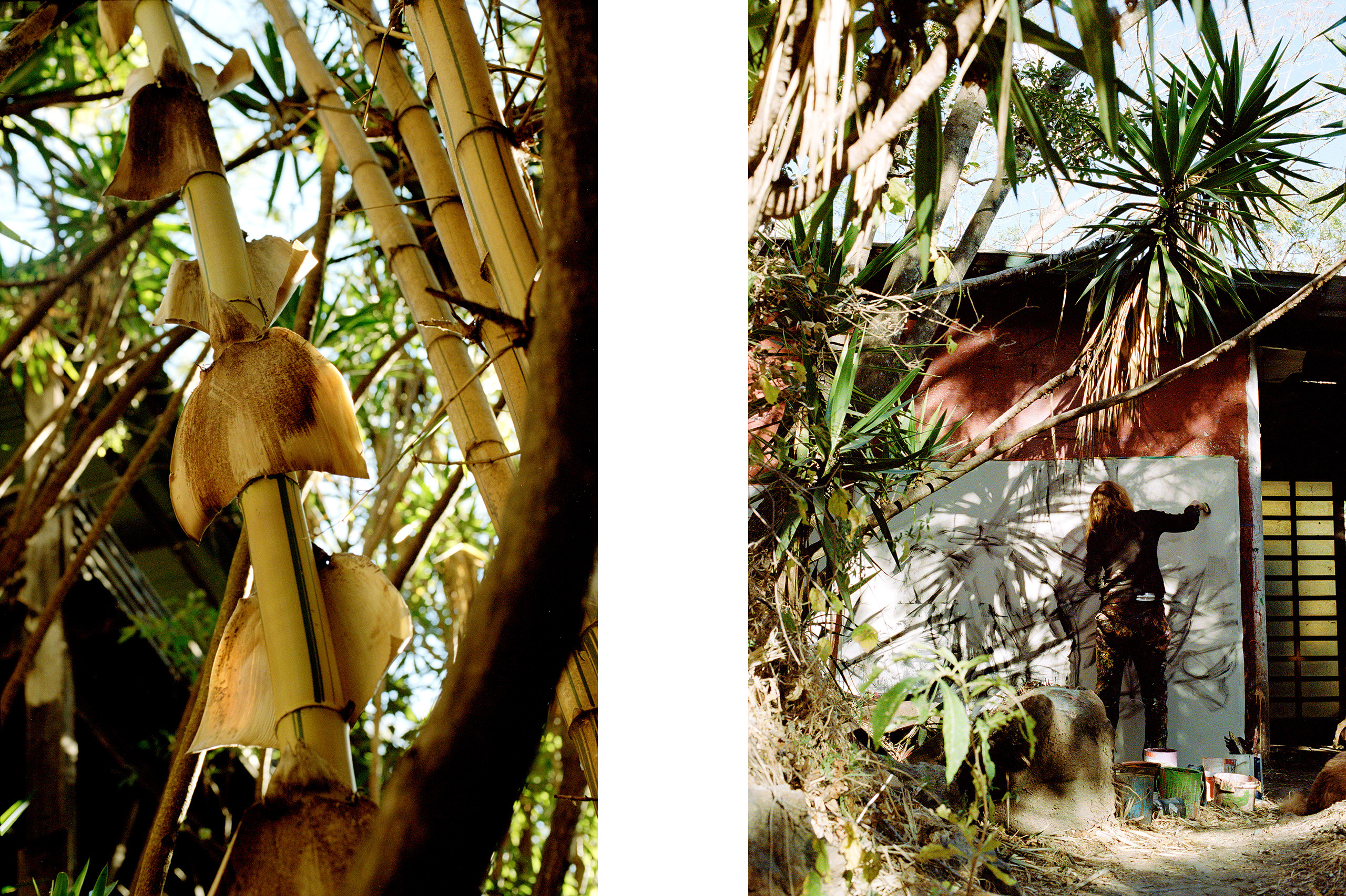
You grew up as the daughter of a woman artist and became a woman artist yourself, living in Guatemala. What was that like?
When I showed my work at the Galleria Diagramma in Milan in 1981, I remember there were very few women. I was of course a feminist, but it was never a theme for me. I feel more strongly about it now, being in a macho country!
Did you ever, when you were depressed, feel the patriarchal society was not encouraging women artists?
No, because I was encouraged from a very early age. I was born into a family of women artists. My great-grandmother was an artist. I grew up surrounded by this very specific sensitivity toward art. My mother was a model. I had my first show when I was nineteen.
So why did you eventually feel so isolated?
The Swiss artistic scene pushed me aside because I left Switzerland, not because I am a woman. People took it really badly. They didn’t understand why I wanted to get away, as I had had an early success with a first solo show very young, and so on.
Do you remember people being angry about that?
Yes. You are ‘out of the game’, that’s what they told me. That I should not expect anything because I’d gone away, it was my choice. I wanted to prove to them that it was not like that, but it took me over thirty years…
Who told you that?
Some gallerists and especially artist friends…
One aspect that I feel is very feminist in your work is the way of occupying space. Yours isn’t a self-effacing work. It’s something very strong, an affirmation. When you set up an exhibition, you sort of envelop all the space.
That is an intention of mine, a need. But yes, my work is a physical experience. I am a physical painter. I like big gestures, I need to move, I’m not someone who sits at the table, I like to stand and need to move. I’m active. It’s my way of liberating myself.
When we look at your art now, it seems close to the aesthetic of the 1970s: the taste for nature, textile, colours, the hippies. What was your relationship to the hippie movement?
I married very early, when I was nineteen. Probably in part so as to get away from home. But neither my husband nor I were hippies.
I can see some hints of Expressionism in your paintings. Would you say that artists such as Sam Francis and Morris Louis are in your mind alongside the colours of traditional Argentinian art?
Yes, I met those American artists at documenta 5 curated by Harald Szeemann in 1972. I wasn’t aware of the influence at the time. But yes, we have these colours here in Guatemala too. When I lived in Basel, I was also close to the Swiss artists of that time; some of them, such as Martin Disler and Miriam Cahn, had affinities with Expressionism. I was also a friend of Markus Raetz, but I could add many more names.
What about the influence of the Latin American avant-garde, magic realism?
I got to know some very interesting artists in Mexico, Guatemala, Argentina and São Paulo. Maybe the magic realism in Latin American art and literature is more of an influence than I think, as my grandmother always told me many stories as well.
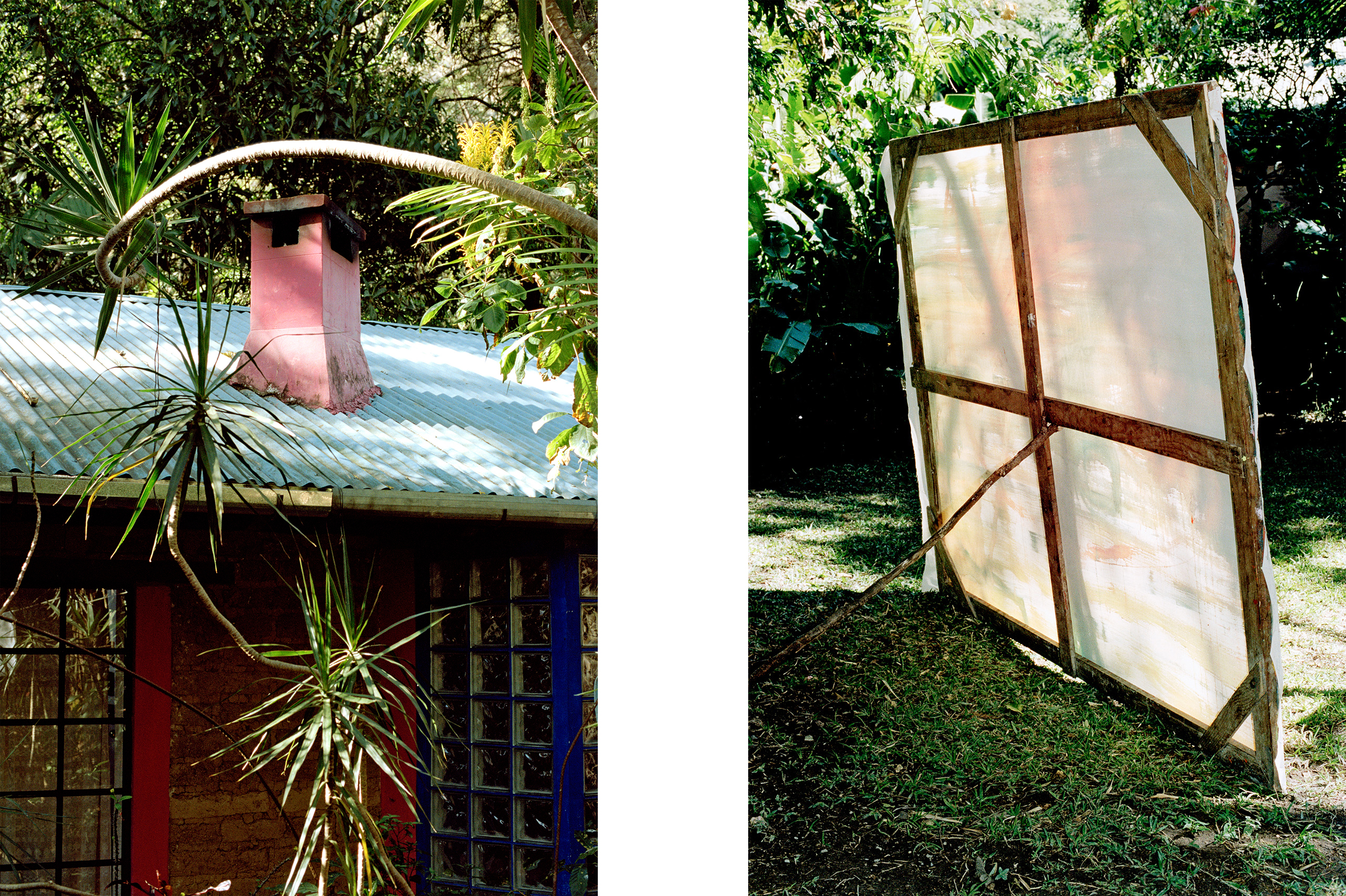
Could you briefly describe your experience with curators such as Jean-Christophe Ammann and Adam Szymczyk?
I first met Adam Szymczyk when he was director of the Kunsthalle Basel and invited the same group of artists from the show 6 Künstler aus Basel in 2011 that Jean-Christophe Ammann presented 30 years earlier when he was directing the Kunsthalle Basel. After that, he invited my mother and me to a group show called Olinka, or Where Movement Is Created (2012) at the Museo Tamayo Arte Contemporanéo in Mexico City, and our relationship has grown since then.
Meeting him was magical for us, as it changed our lives for the better. I was suddenly back on the radar and eventually had several shows. My work aroused the curiosity of curators abroad.
There was this important moment of your retrospective show Vivian Suter: El bosque interior (2018) at the Art Institute of Chicago and the very first acquisitions of your work by an institution.
I was very glad when the works were looked at by the restoration team at the Art Institute. They bought many artworks, about seven- teen, and we exhibited them. But before that, they looked at them and it was very good to know that they accepted them.
Were you afraid that they would not accept them?
Yes. Because the canvases had natural things on them, the rain was on them, and so on. But that was fine, and now the paintings are there in Chicago. For my exhibition at Tate Liverpool 2019 they also bought one piece, the one from Kassel. Their restoration team took things very seriously. I realised that it is possible to preserve them, it’s not dangerous or anything.
Some time ago, in 2005, a hurricane flooded your studio. What happened to your paintings?
I saw all the works there in the mud, floating around. The ones hanging on this structure I used were also muddy, and it was devastating for me to see that. My life’s work was gone. In the house everything was destroyed, we had to move away, a dog drowned.
My mother was in a wheelchair. The rescue service came and we had to stay with the neighbour and spend two months in a hotel near the houses until they had all dried out again. It was a while until I went back into the studio, I was scared. But slowly we let the mud out and I saw all the pieces drying. And I saw this other possibility, that what happened could be a part of the work.
The paintings were buried for weeks. They had marks of water, mud, leaves. It was a turning point when I accepted that my paintings were not destroyed but transformed. They recorded an experience. After that, I decided that I would not fight against nature anymore, but work with it.
Before that, would you say that the canvases were considered as precious objects?
Never really, because I already worked up in the mountains, so it was always a bit rough for the paintings. But after the hurricane, my point of view changed.
How did these events change your way of painting, and how do you think about nature since then?
I accepted the weather as part of life, so to say. I accepted that other factors also influence the treatment of my painting. I let nature come into it. When it rained, I left the painting outside and looked at it the next morning to see what had happened. It was a decision I made. Rain could fall, an animal could come along, what- ever…
Guaranteeing a long life for my painting is not an issue for me. But on the other hand I can say that my encounters with the restorers at Tate or the Art Institute of Chicago were very interesting. They accepted the state of my painting. I never thought of preservation.
Do you mean that the shows have to look like the place where you are working in the forest?
Yes, I establish a proximity with where I stay outside. I need that feeling to come across. That’s why I hang the paintings differently, and that’s why they are not stretched. Some of them even lie on the ground. That said, sometimes I leave some stretched to make a comparison with the unstretched ones.
As an artist living in the forest, how do you feel in the museum surroundings?
It was very nice to see my works in a different context from where they were made. I was often asked ‘why don’t you make smaller paintings, so that you can sell them?’ I always thought, no, I make these paintings, I like to work big. There will be museums that will buy them. It was in the back of my mind, just like a dream. And now it is coming true.
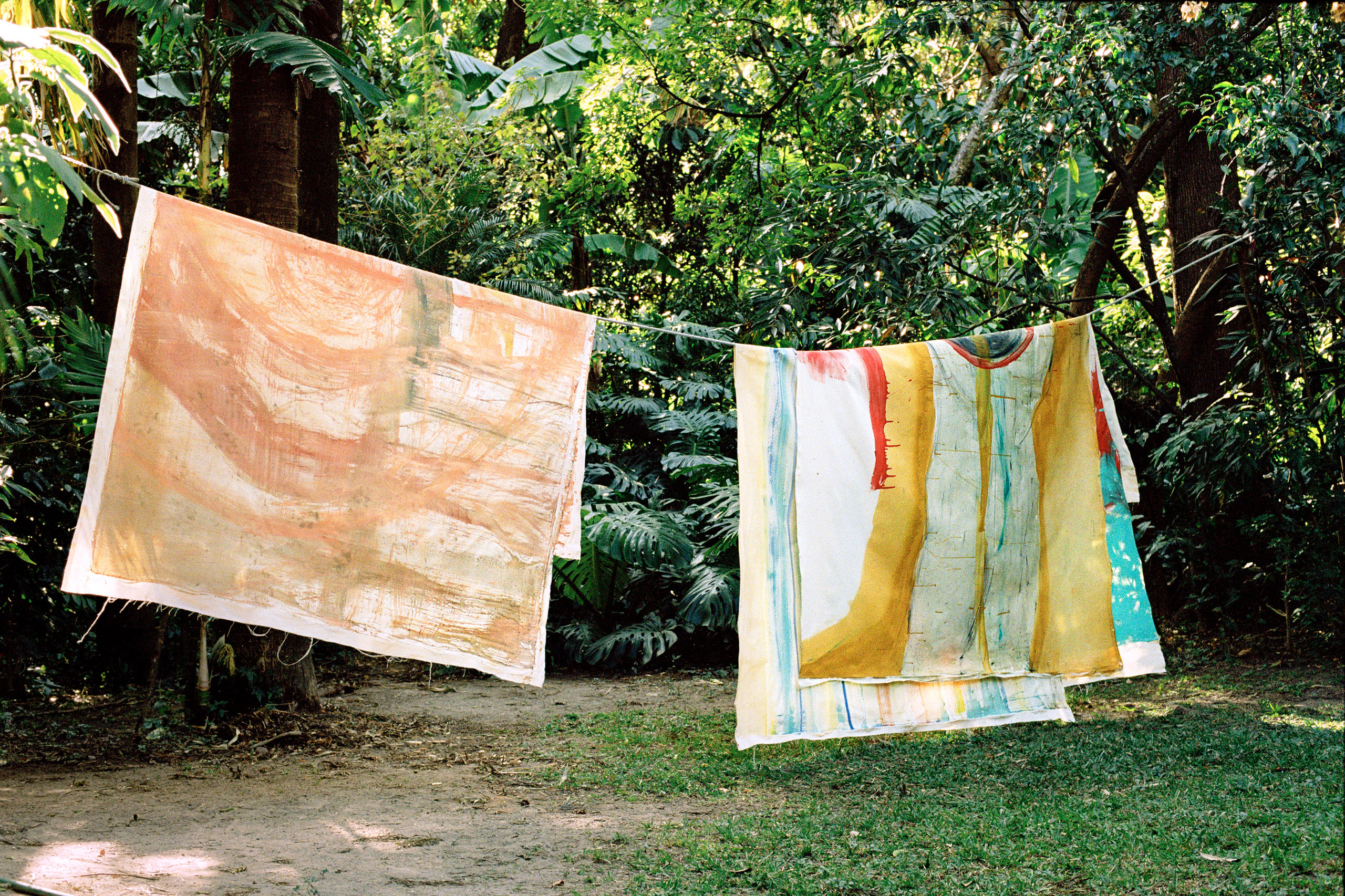
Was it ever difficult, lacking the recognition that you now enjoy more and more?
Yes it was. It needed a lot of willpower to continue working even though I didn’t get any recognition at all, or the little that I had was always very critical. The criticism wasn’t very inspiring, I have to say. But nevertheless, I carried on.
You were always convinced this was the right choice, even though you had some hard times?
Yes. I didn’t see any other alternatives. I really liked working here and being exposed to nature. But I also liked it when I was in Greece, where I could paint on the beautiful volcano on the island of Nisyros to produce my work for documenta 14 in Athens. That’s when I realized it was also possible to make my work somewhere else. It was a very nice experience. It was also great to be able to show my work outdoors at a very special place.
You’re not a nomadic person?
I used to be, when I was younger. I travelled a lot, all over the world. I was in Africa, Asia, Australia. I enjoyed getting to know people there and being in the natural environment. It came into my art and sometimes I worked on it while I was travelling. During a trip to North and Central America I discovered Lake Atitlán…
And then you settled here and became sedentary…
Yes.
Your mother (Elisabeth Wild, 1922–2020) was an important artist, and you lived very close together until she died last year. Could you tell us about the first moments of your fascination with the arts and the role your mother played?
I grew up while my mother was painting, so I don’t remember any time in my childhood without art. We lived in Argentina until I was thirteen. Then we moved in Switzerland, where I finished school. I went to the arts and crafts school in Basel. I attended the painting class but I also studied sculpture, colour, writing, and so on.
How did it feel to be the daughter of an artist?
I didn’t feel any pressure. But we didn’t talk so much about what I was doing. At first I showed my mother my work, then I stopped because she was very critical. But I always looked at her work. We mostly discussed her work.
I can imagine that for your mother, being an artist was a real challenge. She was close to Fernand Léger, and so on. Your work seems much wilder. Do you think you developed your style in opposition to her?
She was very strong, stubborn and hard-headed. She loved that I could be so free. She couldn’t, she was very controlled. It happened that we exhibited our work together sometimes. You could feel a strong proximity and a completely different way of approaching art at the same time.
I’m curious about your childhood and if you still have any of your early drawings.
My mother kept them, they’re nothing spectacular. But as I watched my mother working in her studio, I had to sit as a model for her, and I hated it. But there was no question of doing something else.
My father wanted to get me away from art, because he didn’t believe that I could make a living from it. So I had to try commercial school, but in the end I persuaded him that I should go to the school of arts and crafts in Basel instead.
What was your father’s job?
He printed fabrics for clothing. He had a factory in Argentina. My mother helped by making the designs. I was always there, it was fascinating. I also was always surrounded by printed fabrics.
Can you tell me about the relationship between your parents?
My mother came from a Jewish family from Austria. When Nazism started to rise, her parents decided to flee to Latin America. They were very much interested in culture and the arts.
Since they had to cross Europe to get to the Netherlands, they decided they couldn’t possibly leave Europe without seeing Venice. So they decided to spend a few days there, before catching the very last cargo boat leaving for Buenos Aires. They narrowly escaped the atrocities that were happening in Europe. They arrived in Argentina in 1939.
Your mum immediately enrolled in an art school.
No, she had to work to support her family. My grandfather had a disease of the eyes, he went blind for a while. But she became a member of Círculo de Bellas Artes in Argentina. She had private lessons with an old painter from Vienna and then another German painter. After that, while I was still very young, she took me to classes where she made pottery.
She had her first shows at the Fine Art Institute of Buenos Aires. Her parents helped and encouraged her to do that. My mum was sixteen when she started work. She was a nanny for very rich Argentine families. That’s what she learned earlier in Vienna. She also worked in Yugoslavia and learned the Montessori principles there.
Do you think she educated you in the Montessori principles?
Maybe, but I don’t think she was aware of it.
How did she meet your father?
My father was a Swiss industrialist with a factory. He was doing very well, but after Perón started to nationalize industry in the mid-1950s, he decided to pack up and go back to Switzerland in 1962, when I was thirteen.
My parents met when my mother went to offer her design to my father in his factory. He was much older than her and already had children. One was the same age as my mother and the other was older. My mother was in between two generations. It was quite odd and difficult for her. The communication was not very good between my parents. I was closer to my mum, although my dad was very loving. He had his own world…
It seems that in the family everybody had a ‘world of their own’…
Yes. My father went to France, then to Turkey and then Argentina. He moved around a lot and each time he created his own environment.
How was it for your mother moving to Basel as an artist?
She did sell a small number of paintings. When she had her antique shop in Basel, she liked to buy old paintings and do them up so that they could be sold. She also painted cupboards and restored ceramics, porcelain. But she was very much isolated in Switzerland. She didn’t know many artists, and that’s why she opened a shop.
How did she come to join you in Guatemala?
At first she came almost every year to visit us, until there was an opportunity to buy a little piece of land behind where I live. Ever since then, we lived next to each other, until she died last year. We lived close together, working every day in our own studios, meeting for lunch and dinner, helping each other, sharing almost everything.
Interview originally published in “Swiss Grand Prix Kunst / Prix Meret Oppenheim 2021” (Art Bulletin, July/August 2021), in which the prizewinners give a deeper insight into their respective work. The publication can also be ordered free of charge at swissart@bak.admin.ch.
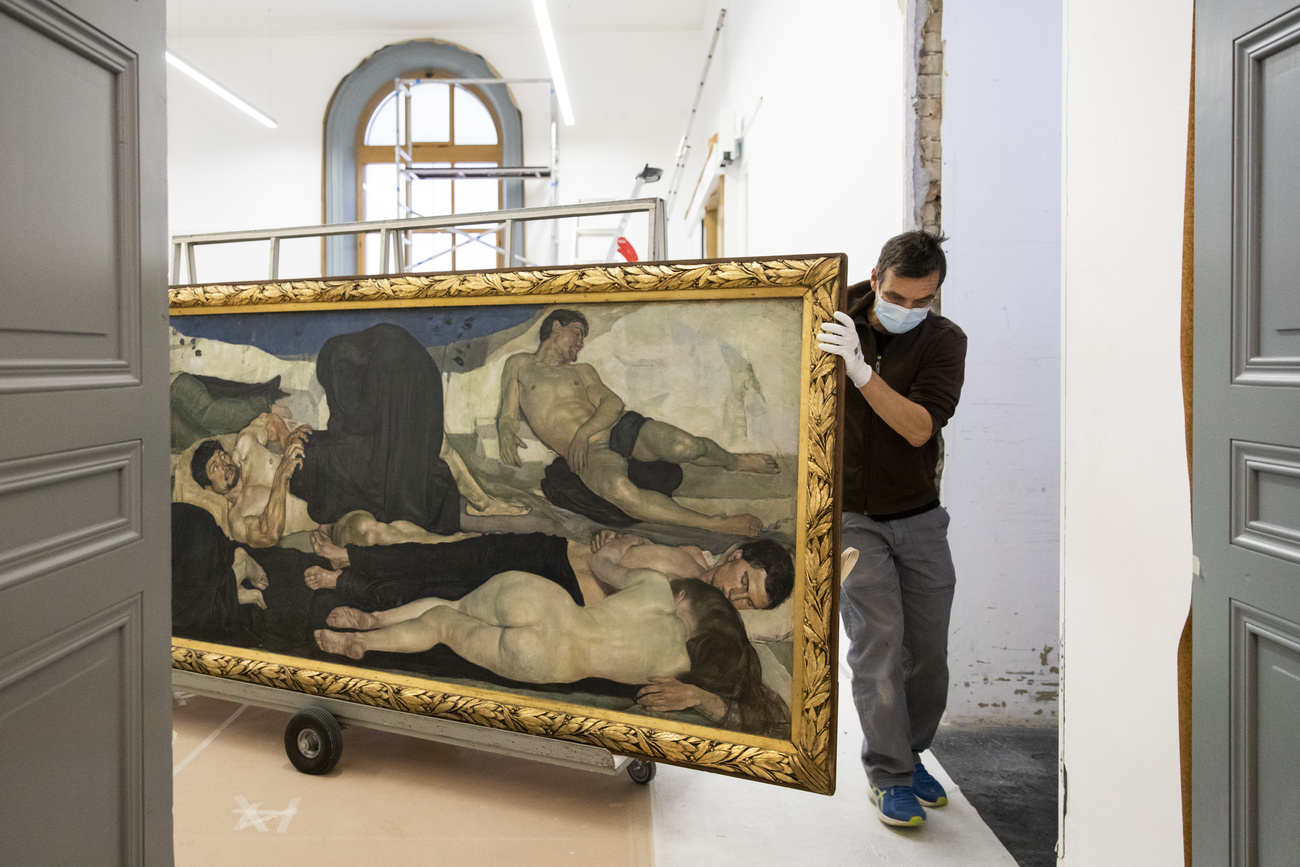
More
Women remain largely under-represented in Swiss museums

In compliance with the JTI standards
More: SWI swissinfo.ch certified by the Journalism Trust Initiative







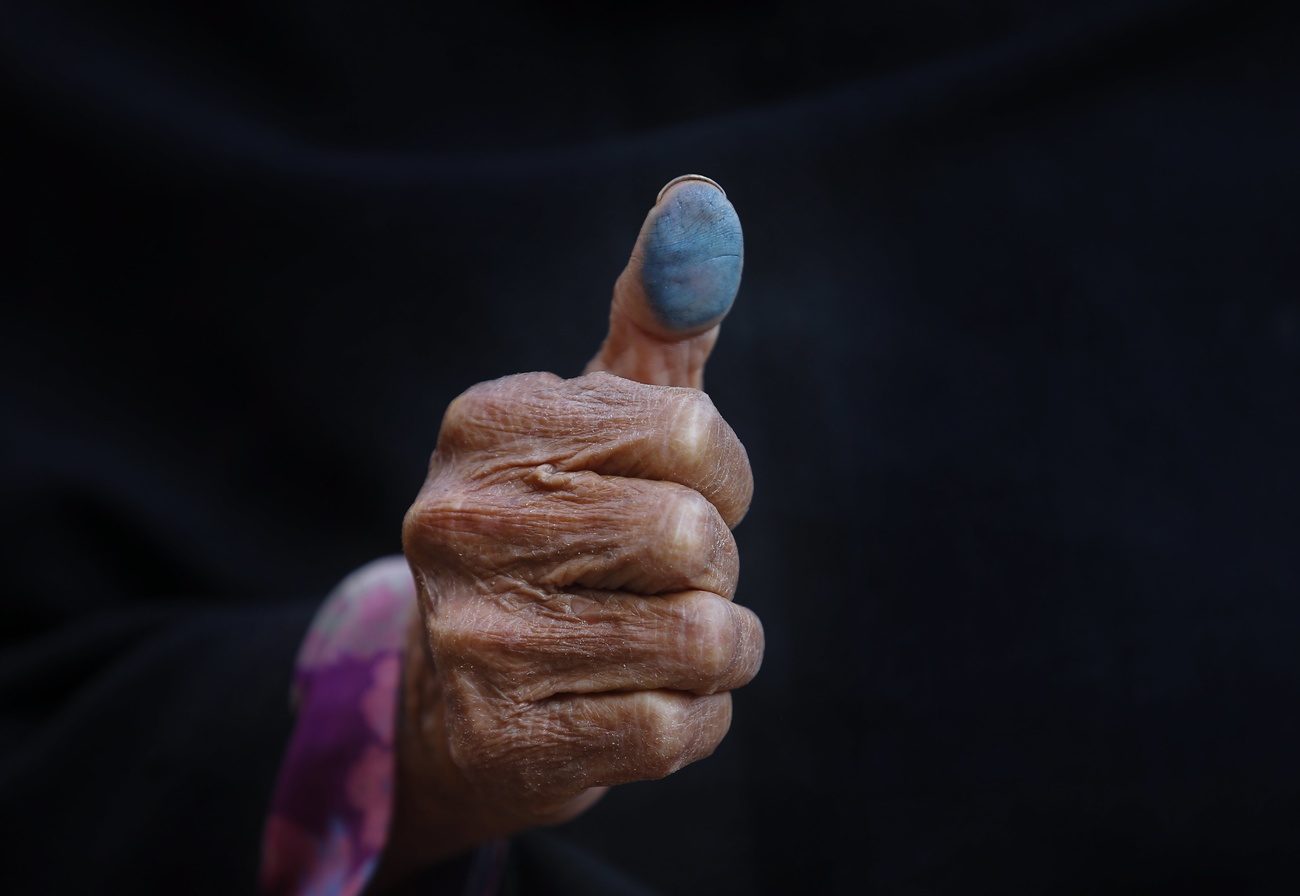





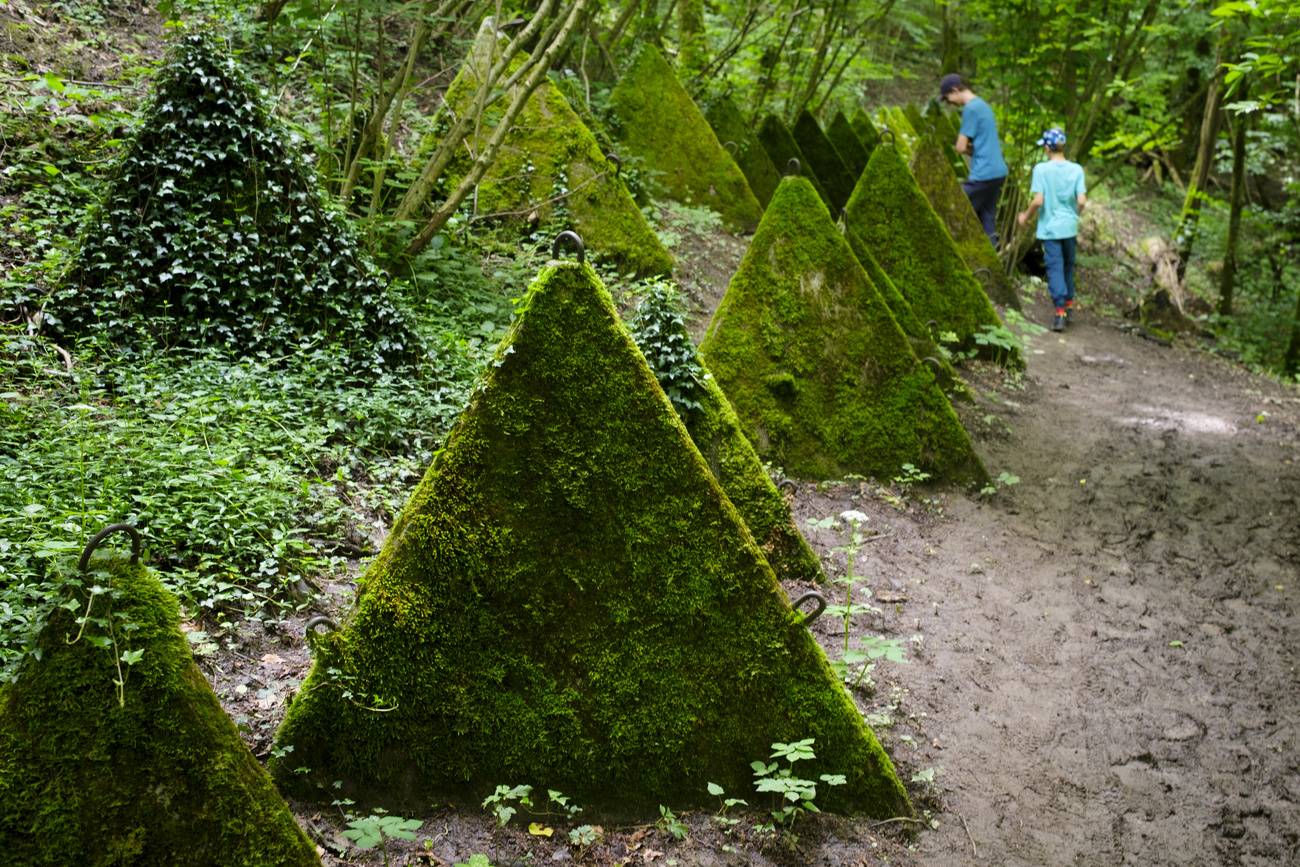





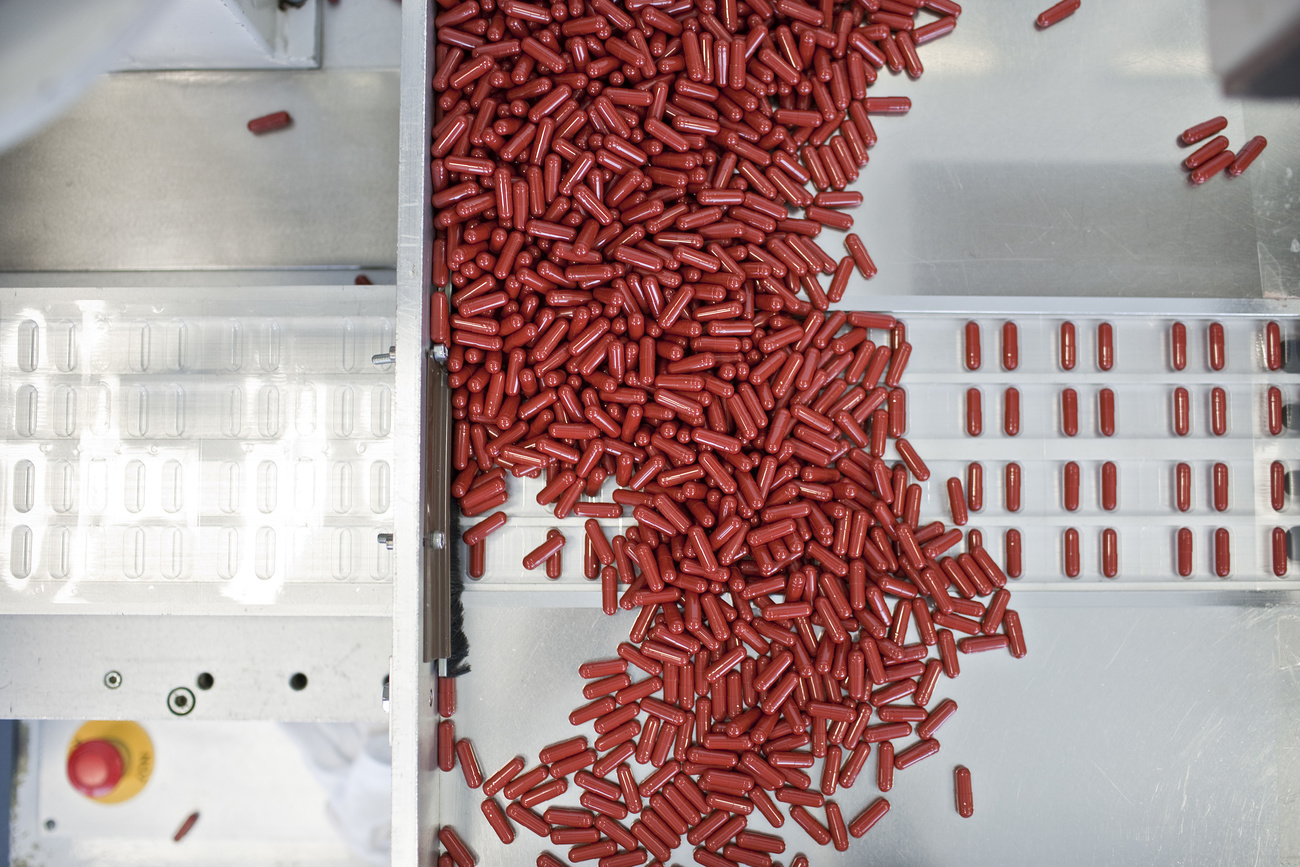














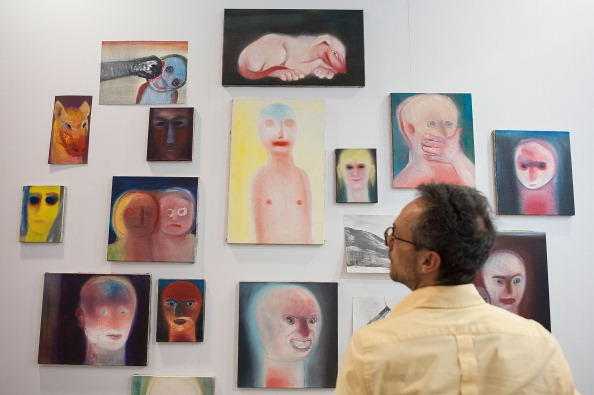
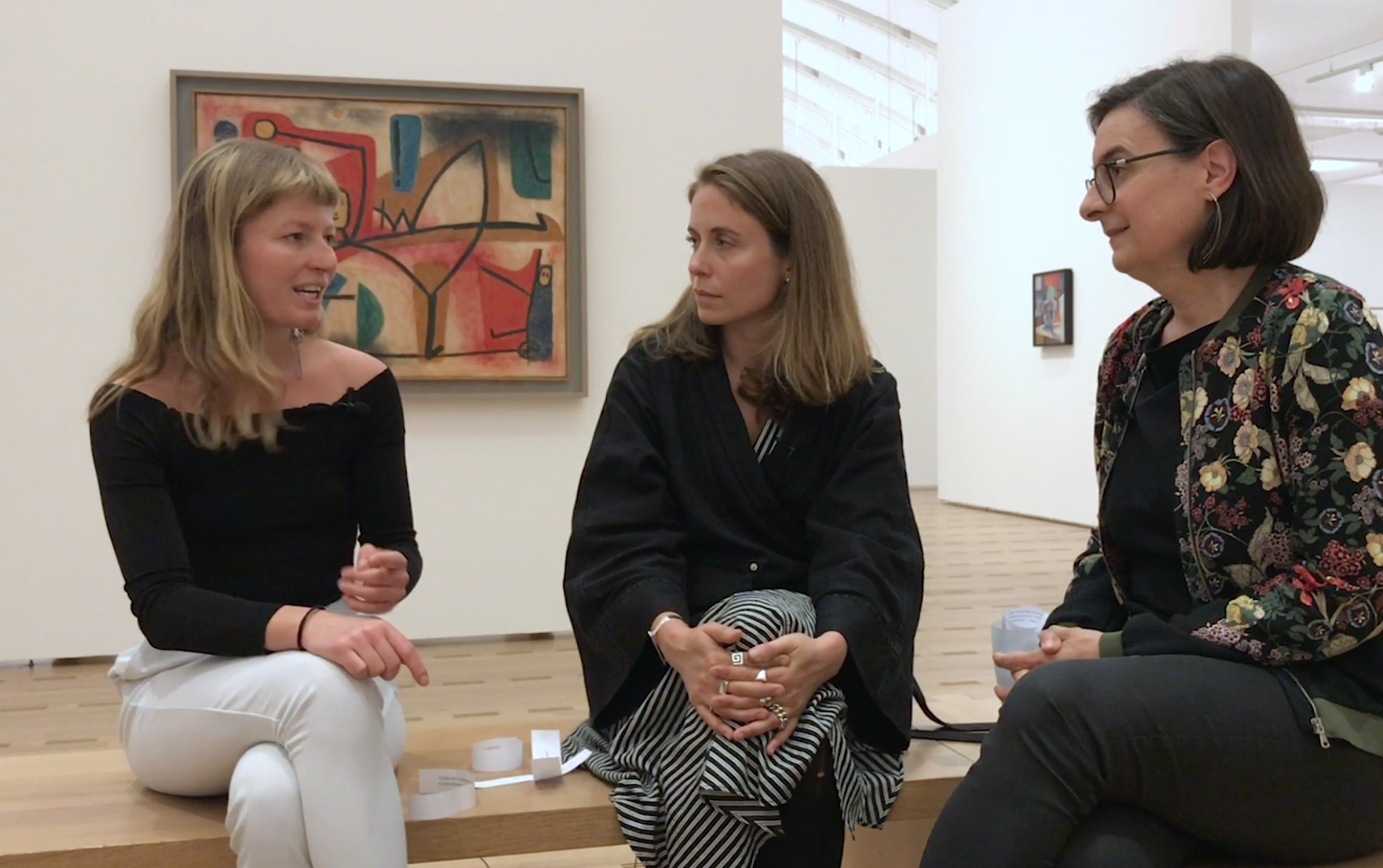
Join the conversation!